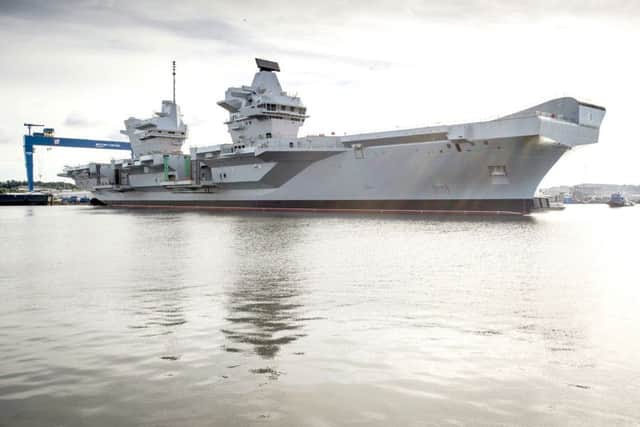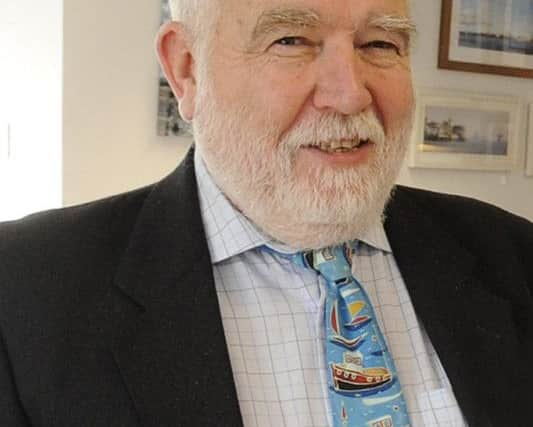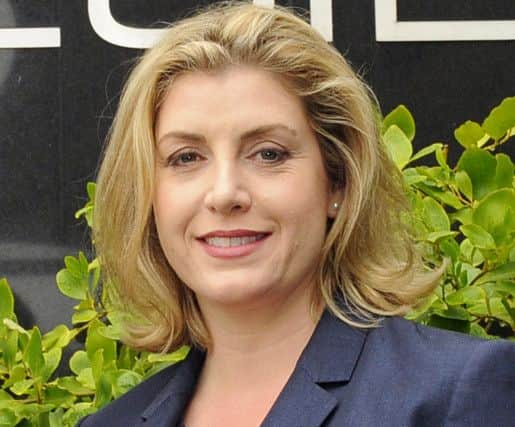The Royal Navy's new aircraft carriers: National Audit Office reveals what progress has been made and what the risks are now


A shortage of key personnel could jeopardise the effective deployment of the Royal Navy’s two new aircraft carriers, the Whitehall spending watchdog has today warned.
The Carrier Strike programme was entering a ‘critical’ phase with the first of the ships – HMS Queen Elizabeth – nearing completion and due to make its inaugural sailing this summer, the National Audit Office (NAO) said.
Advertisement
Hide AdAdvertisement
Hide AdIt will mark the start of a ‘high risk’ period of trials, testing and training to bring together the carrier with its Lightning II fighter jets and helicopter-borne Crowsnest radar in an integrated force.


Already the first sailing has been put back three months and the NAO warns further ‘technical issues’ could mean the Ministry of Defence’s plan for it to be operational by the end of 2020 is delayed.
Among the problems it highlighted was the shortage of engineers, intelligence personnel and warfighting specialists in the navy and RAF air crew.
While the MoD has begun a recruitment programme to address the gaps, the NAO said the number of pilots was expected to be ‘just sufficient’ to 2026, with ‘limited resilience’ if personnel left the forces
Advertisement
Hide AdAdvertisement
Hide Ad‘The department still has a lot to do as it brings together equipment, trained crews, infrastructure and support. Problems in any of these areas could mean that use of the carriers is delayed or reduced,’ the NAO said. ‘The next three years are critical as the programme moves into a high-risk period of trials, testing and training.


‘The technology is innovative and operational unknowns, which will only become clear during testing, may affect plans and increase costs.
‘To recover earlier delays, the department has already compressed the timetable and is running some testing in parallel with other tasks.
‘The closely timed sequence of tasks offers no further room for slippage and there remain significant risks to value for money.’
Advertisement
Hide AdAdvertisement
Hide AdThe NAO said the MoD was already facing a one per cent to two per cent cost overrun on the £6.2bn budget for building the ships, while the forecast £5.8bn earmarked for the US-built Lightning II fighters could be affected by fluctuations in the value of sterling.


In the longer term, the NAO said the deployment of the carriers would have far-reaching implications for the way the Senior Service operates with a ‘significant proportion’ of the fleet required to support and protect them.
The formation of a carrier task group is likely to account for about 27 per cent of the navy’s fleet by tonnage and 20 per cent of the personnel needed to crew the fleet.
‘Currently, the navy carries out multiple operations concurrently using single ships. This means the navy will need to change fundamentally how it operates and make judgements on priorities,’ the NAO said.
Advertisement
Hide AdAdvertisement
Hide AdThe report comes just days after a News probe revealed how the MoD had failed to hit its latest recruitment targets in the Senior Service.


Maritime defence expert Mike Critchley, of Gosport, welcomed the NAO’s ‘honest report’ but stressed the navy had many more challenges ahead. The retired Lieutenant Commander was also concerned by comments by the NAO that pilots for the Lightning II were heavily reliant on simulators for training.
Lt Cdr Critchley added the a shortage of manpower had forced the navy to leave ships alongside in naval bases for extended periods of time.
He said: ‘Targeted recruitment is under way but ships have also been laid up in recent months simply to release trained men and women to take the train to Rosyth to join these hi-tech carriers. The amount of money going into these ships and aircraft are eye-wateringly large and MoD is obviously diverting money in the defence budget from other areas that many naval officers would consider more important.
Advertisement
Hide AdAdvertisement
Hide Ad‘The number of fully operational frigate and destroyer numbers continue to decline and must be worrying as more operational commitments around the world are “gapped” for considerable periods of time.’
Flick Drummond, Portsmouth South MP, said major projects like the Queen Elizabeth carriers’ construction had a ‘degree of risk’.
She said the delays in HMS Queen Elizabeth coming to Portsmouth were necessary to make sure the everything was ‘tested to the highest standard’.
‘That is why there has been a slight delay in the programme, but we have to look at it in context,’ she said,
Advertisement
Hide AdAdvertisement
Hide Ad‘This is a programme which has been under way for more than 20 years, and has had to survive the biggest financial crisis any government has faced in peacetime. So, on balance, I think we can be happy with where we are.’
Former armed forces minister Penny Mordaunt also welcomed the NAO’s report but said the nation could not ‘rest on its laurels’.
The Portsmouth North MP said: ‘The carrier programme has been the largest engineering project the UK has ever undertaken, and the logistics are immense.
‘However, whether it is making the harbour ready, power supply, manning, pilot pipeline, or getting shipyards around the country to build with such accuracy that she could be assembled in Rosyth, the Royal Navy and her supply chain have delivered.’
Advertisement
Hide AdAdvertisement
Hide AdAn MoD spokesman said: ‘The introduction of the largest warships ever built for the Royal Navy, the Queen Elizabeth-class aircraft carriers, together with our F-35 jets, and the Crowsnest surveillance system, will transform our ability to project power around the world. We welcome the NAO’s recognition of the progress we have made in bringing them into service.
‘HMS Queen Elizabeth will be accepted by the Royal Navy as planned this year and we will also take delivery of a further six F-35s in addition to the eight already delivered.
‘With sea trials expected to start in the summer, we recognise that there are challenges ahead and remain committed to delivering the full range of joint F-35 and carrier operations by 2026.’